Focus on the rehabilitation of severe laminitis following a case of severe lymphangitis.
A rescue achieved thanks to the collaboration between farrier and equine veterinarian.
Food, infectious, mechanical… the origins of laminitis
The known causes of laminitis are varied. From dietary origin, mechanical/traumatic, medicinal, infectious or even endocrine origin, laminitis remains a serious pathology of the equine and requires immediate veterinary care.
The intervention of the farrier is necessary at a later stage, when the acute phase of the disease has been controlled.

Concerning the mare followed in this blog article, the onset of laminitis is due to a serious alteration of the lymphatic circulation of the limbs.
The mare first presented signs of mild laminitis without any real difficulty of support for experienced professionals. A situation which has deteriorated extremely, despite the great experience of the team which supported her.
From mild laminitis to hoof sloughing
At the origin of this case, the mare did not present a particular predisposition for laminitis. It is an improbable meteorological phenomenon which is at the genesis of her pathology.
The stables where the mare is boarded are located in the open ground, in Normandy, France. A region little known as having unpredictable weather.
Yet in June 2022, the equestrian structure was crossed in an instant by a tornado!
In just a few minutes, equipment, horses and owners were trapped in the heart of violent winds reaching 200 km/h.
Many equines are mutilated by dismantled shelters, transformed into protruding projectiles. An important chain of solidarity between riders, veterinarians and residents of surrounding villages is mobilizing to help injured horses.
Original video of the storm recorded on the Facebook page “Ecuries du pré sablé”
During this episode, the mare suffered major bruises, probably hit by flying equipment while she was in the meadow at the time of the incident. She was quickly repatriated to a veterinary clinic to provide her with the appropriate care.
The animal presented with pain in the hindlimb, compatible with a possible fracture. After examinations, no bone lesion is to be deplored. Put on antibiotics to control the edema and the evolution of the wounds, the mare does not respond to the treatments. She declares severe lymphangitis in the limbs, the first step towards an unpredictable deterioration.
The swelling does not decrease despite the treatment by the veterinary team, the use of critical antibiotics and hospitalization. A high fever also appears.
At this stage, the mare has real vascular problems in her limbs and feet. She declares a laminitis consecutively to this phenomenon. The team detects a tilt of the 3rd phalanx on the right front. At this time of treatment, the laminitis seems rather light. A classic protocol in the treatment of laminitis in farriery is then adopted. Slightly raise the heels in order to relax the deep flexor tendon and limit the constraints on P3.
The left forelimb will also be affected a few months later, without phalanx tilt for this foot.
During the months following the accident, the mare was placed in a boarding house that could accommodate her and provide convalescent care. She must also stay for a few weeks in the clinic to ensure that her general condition improves but also to prevent any worsening of the laminitis.
Cryotherapy treatment is also carried out. Despite all the means implemented, the coronary bands of the feet necrotized and the team witnessed a hooves sloughing.
Degradation will continue despite the preventive and curative care provided. Unable to stand up, the mare will partially loose her hooves.

Laminitis care and monitoring
In this case, one of the issues sought was to improve the greatly diminished vascularization of the feet affected by laminitis.
The lower part of the foot was no longer vascularized, as shown in the phlebogram opposite.
During the acute phase, it is forbidden to apply a shoe immediately. The horse is not able to withstand the act of farriery and the risks of worsening the lesions of the affected feet are major.

It is nevertheless advisable to provide support for the back of the foot at the first signs of suffering in order to relieve the animal.
The application of support to the frog and heels is then implemented thanks to bandages and an 8mm thick polystyrene plate for example.
In the case of this mare, necrosis of the feet led to detachments of several parts of the hooves capsules. Some of them penetrated the soft flesh of the coronary band and the top of the foot.
Under the weight of the mare and the separation of the structures of the feet, the mare “sinked” into her own hooves. A phenomenon that can be observed in the most serious cases of laminitis, where the soft tissues no longer ensure the overall stability of the foot nor the usual positioning of the third phalanx.
Certain internal parts of the foot become visible from the exterior, notably the coronary band. The application of dressings is essential in this type of situation.
On this mare, the sole was also perforated by the third phalanx.
In the case presented in this article, the farrier/veterinarian duo applied a glue-on horseshoe to save as much as possible the lower parts of the feet where parts of the hoof capsule was still present. On the upper part of the foot, the dressings had the effect of protecting the areas without a hoof capsule. Taking into consideration the future wall to grow was of capital importance.
The orthopedic shoe applied throughout the treatment was an ACR Rocking Shoe (ACR 360) in order to stimulate as much as possible and restart blood circulation in the hooves. The installation of the fittings, their positioning, the application by gluing or broaching etc. were adapted to each intervention as things were improving.

April 5, 2023
Objectives sought during this intervention
Transition from ACR 360 fittings to more simplified fittings. Need to slightly lower the heels, shorten the toe, place the phalanx flat, maintain good protection of the foot.
Discussions between the veterinarian and the farrier made it possible to opt for a 100% personalized solution to the atypical case of the mare.
A rocking shoe with the support of the frog in addition to a flat leather plate for maximum protection of the sole (unlike plates with frog opened which do not offer toe protection).
Observations before shoeing:
- Loss of sole thickness compared to previous x-rays
- Toe alignment that needs to be reworked
- Too high in heel. A realignment of the whole is necessary
After trimming/shoeing:
- Satisfactory realignment of the phalanges
- P3 distanced from the ground
- Good protection of the sole
- Wall better aligned with the dorsal aspect of P3
- Horizontalization of the third phalanx (slight derotation of P3)
Protection of the sole ensures that maximum structure is maintained for the foot.
During the monitoring of the animal, and depending on its capabilities, a dynamic control of her is carried out in collaboration with the veterinarian and the farrier.
The locomotion of the horse is then assessed in a straight line, on the circle, at a walk, at a trot when possible. The professionals observe the evolution of locomotion from intervention to intervention, the presence of discomfort/lameness, the amplitude of strides etc.
In the case of this mare shod with 360 shoes, the team was able to observe that the mare was trying excessively to shift her weight onto the toes.
Observations in motion allowed us to note that over the months and weeks the mare gradually accepted a flatter hooves position, indicating a positive evolution of her state.
Static, the quality of the regrowth of the wall, the palpation of the coronary bands etc. are indicators of good rehabilitation.
The radiographic control makes it possible to follow the correct evolution of the internal structures of the feet and to manage certain decisions in farriery (trimming strategy + shoeing).
The thickness of the sole, internal/external balance, angularity, toe length, control of the growth of classically high heels in laminitis horses, monitoring of the proper maintenance of the derotation of P3 etc. are discussed in collaboration with the farrier/veterinarian to determine the best strategy to adopt.
In terms of activity, restriction of movement was necessary during the 9 months following the accident. The mare was no longer able at first to move but also to avoid deteriorating her critical condition.
A very progressive and controlled return to the paddock protocol was necessary, with the final objective of fully recovering the mare in the field barefoot.
Towards a personalized semi-orthopedic fitting
The structure of the shoe during the transition from the ACR 360 to a more simplified solution in April 2023 for this mare was composed as follows:
Frog support to bring back the load to the rear of the foot and distribute weight over a larger bearing surface. Contact between the ground and the back of the foot is favored as well as the maintenance of the bony column.

Addition of a flat leather plate cut at the frog to limit loss of sole due to abrasion. The pad is also opened in a toe to limit pain linked to the pedal bone.

Silicone to maintain good contact with the ground, help support the bony column and protect the sole.
Addition of copper sulfate to maintain good foot hygiene by drying the sole and frog. The humidity under the silicone is thus controlled.
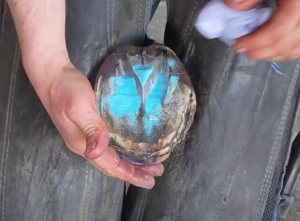
Forged rocking horseshoe. This is made by hand to be as classic as possible. The challenge when forging this type of orthopedic horseshoe is to correctly balance the curve in the middle. A mandatory condition to maintain the slight unstable effect of longitudinal rocking. Without this balance, the horse will constantly load either at the heel or toe without the possibility of varying its weight back and forth as it wishes.
The particularity of a shoe of this type is to favor the vascularization of the foot.
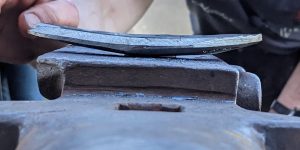
All of these different layers are linked to each other via nails located at the heel of the horseshoe.
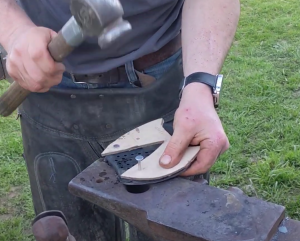
The mare is shod every 5 weeks at this stage of rehabilitation.
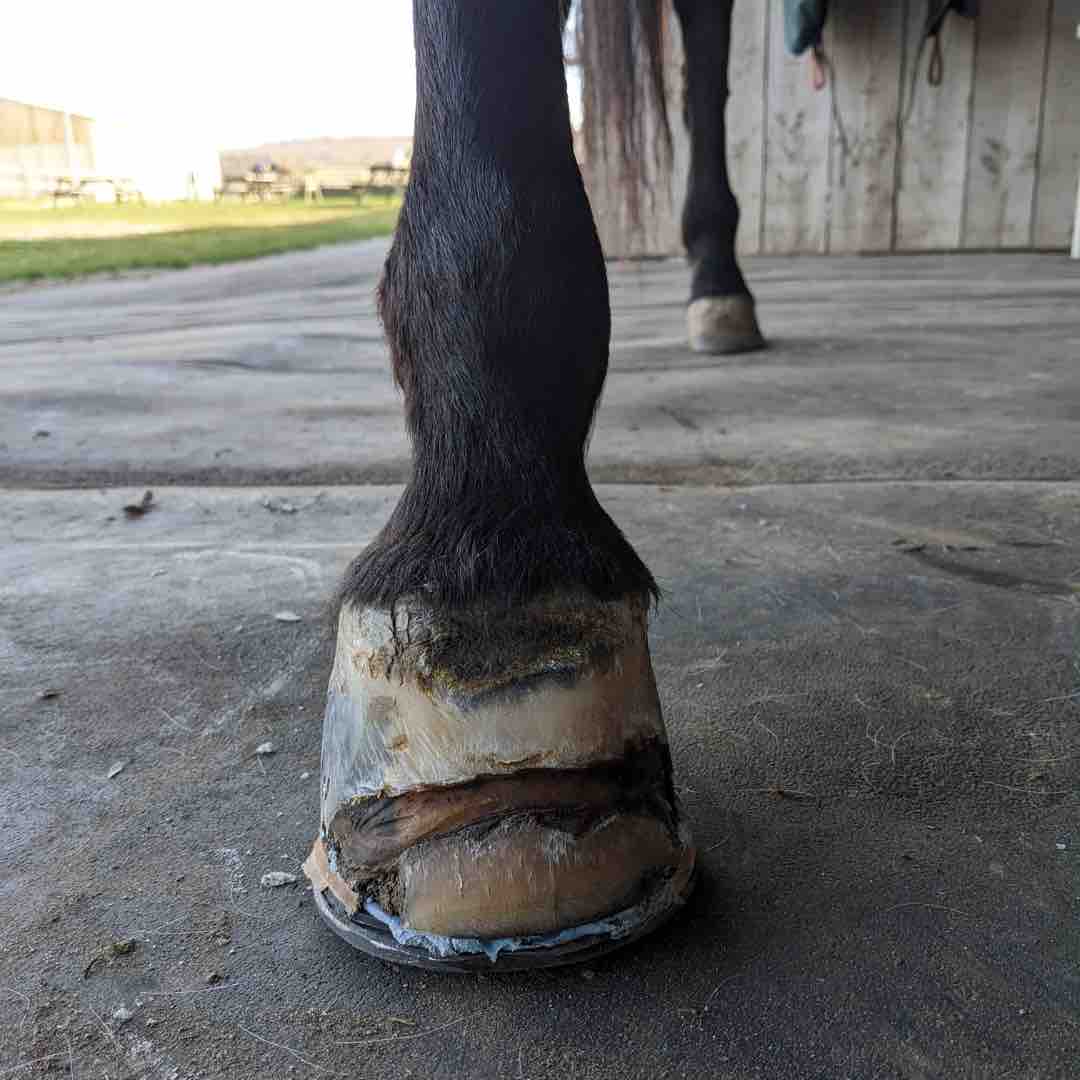
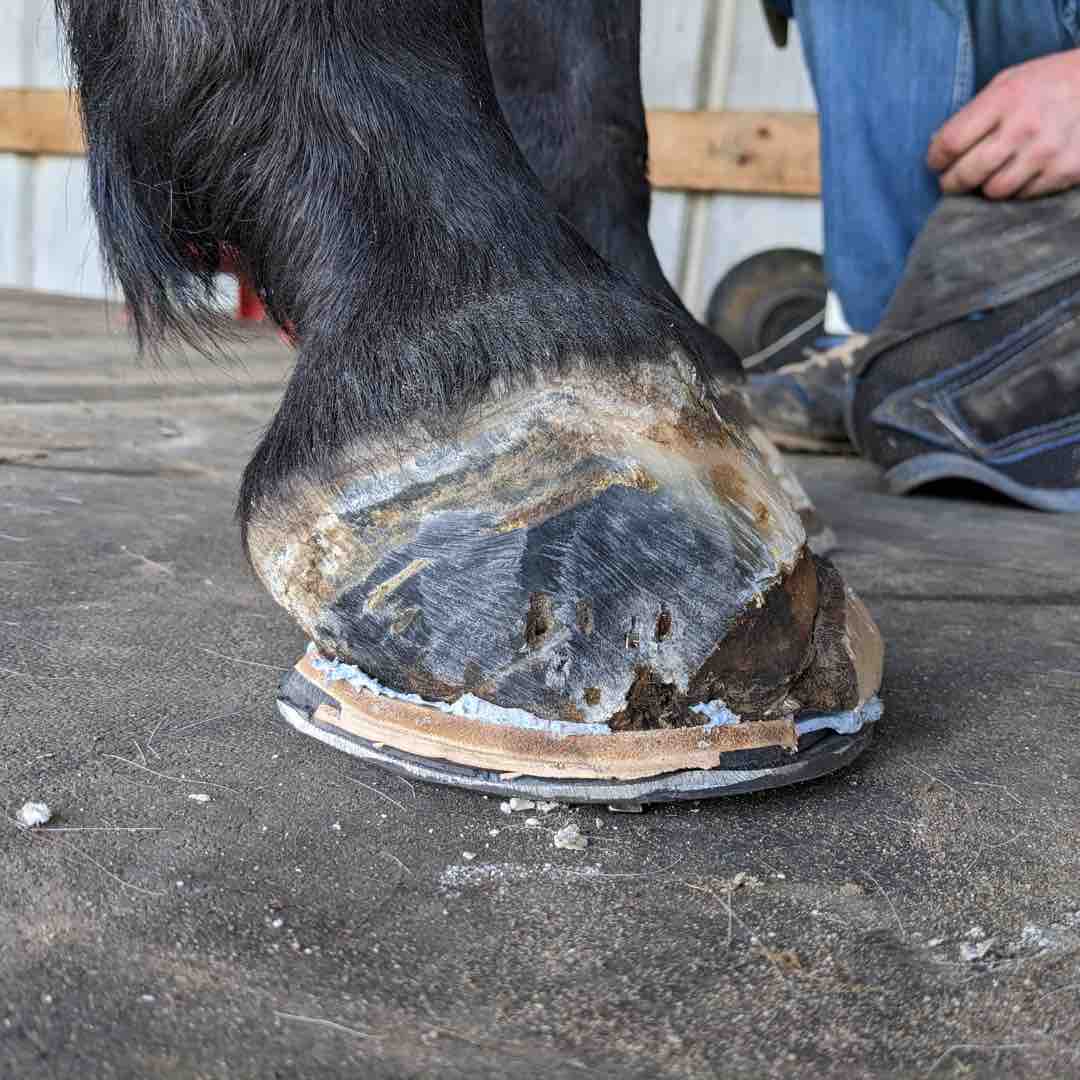
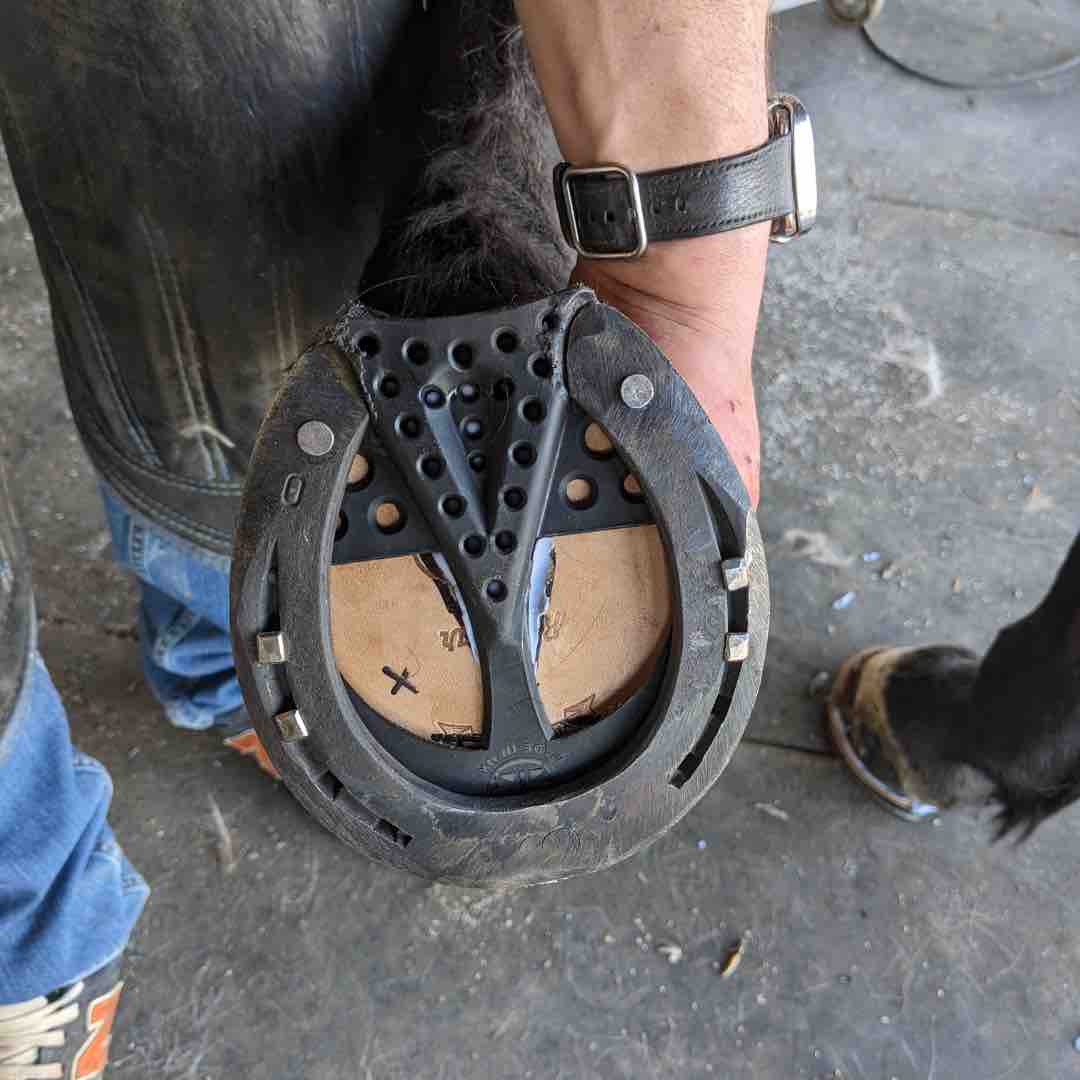
The value of documentation

Documentation of cases, fitting carried out under radiographic control, phlebography etc. are tools that make it possible to monitor the good progress of horses in care.
Carrying out trimming and shoeing under radiographic control may be perceived as a constraint by some owners. Indeed, the costs linked to the intervention of the veterinarian as well as the farrier are more significant.
However, this is a phase to be carefully considered because the horse is thus monitored in the best conditions to increase its chances of healing, limit possible complications and prevent recurrences.
"It is always very interesting in my opinion to control radiographically what we do." shares with us the equine veterinarian in charge of this case of serious laminitis.
"Despite all the experience that we (veterinarians) and farriers may have, we are sometimes led to modify certain small things in a very tiny way, by only a few millimeters without really noticing... While the repercussions can be harmful for the healing of the animal.
This does not mean that we must systematically carry out x-rays, this is not the case when things are going in the right direction, when the foot is easily readable.
But in a case like this mare, the feet have been modified so much that it seems essential to me despite the experience.
Also, the big advantage of doing post-trimming x-rays is to be able to evaluate the evolution from D-0 to W+5, to observe how the foot grew and evolved during the 5 weeks .
External reading of the foot is essential, but internal information is also, in my opinion, absolutely necessary as a supplement.
With the experience, of course we gain knowledge but sometimes things do not evolve as we expect. This is particularly true with laminitis.'
Hoof tracking and analysis
The difficulties of severe laminitis: words from horse owner, equine veterinarian and farrier
Heavy and time-consuming care protocols, financial costs, doubts about the animal's possibilities of recovery... The difficulties linked to laminitis can be significant.
Certain treatments require significant financial and personal investments, whether for the owner and his surrounding, but also for the veterinarian and the farrier.
From the horse owner's point of view:
"Clearly, we had moments of doubt in the case of my mare. I thank the practitioner who took care of her, because out of three veterinarians, only one agreed to engage in the battle." shares with us the owner of the mare presented in this article.
Ekico: Despite this desire to use all possible means to save the mare, was the question of euthanasia discussed with your veterinarian?
Owner : “Yes it was discussed from the start. The vet was transparent with me. She told me that she would do everything possible for my mare, that she did not know if we would be able to save her or not, but she informed me that she would stay in the comfort of the animal. Euthanasia was a possible outcome if the mare did not respond objectively favorably to all our attempts.
I agreed with this.
I also have complete confidence in my veterinarian and my farrier. Both have invested a lot personnaly by asking advice from their side on the chances of recovery of my mare. These are things that bring comfort to the heart to see this mobilization.
It was especially during the necrosis phase that it was particularly impressive and difficult.
Every day we redid the dressings with no noticeable sign of improvement. The mare's hooves seemed to be rotting from the inside, the associated odors were very strong. I thought we would never get out of it.”
Real or supposed effects, some owners initiate additional personal steps in the hope of helping their horse in addition to the care conventional: Osteopathy, shiatsu, food supplements, even animal communication.
From a financial point of view, cases of serious laminitis represent a significant cost. Daily monitoring, consumables, mobilization of the veterinarian associated with that of the farrier, etc. increase the expenses linked to this type of care.
Using horse insurance/mutual insurance can be advantageous because they cover part of the veterinary costs (hospitalizations, regular consultations, medications, etc.) up to several thousand euros depending on the case. Treatment for serious laminitis can cost around €10,000 in the first year.
From the veterinarian's point of view:
“This case was particularly complex. The management of lymphangitis, the fact that she did not respond to the usual care and treatment protocols, the management of her feet...we wondered several times if we were going to reach the end.
The mare character, which I think is a factor that plays a role. But also and above all, its owner was extremely involved in healing, without dispersing herself in multiple directions. She followed the advice and recommendations that we had with her farrier.
The environment of the stable is also a favorable factor. The owners took turns and supported each other in providing supportive care, pressure sore care when the mare could no longer get up, changing dressings, etc.
On the professional side, the involvement was also important. At certain times, we came with the farrier once a week. Some interventions took up to 3 hours.
During very critical phases, for example when the mare lost the wall of her hooves, we decided with the farrier to preserve as much as possible the structures still present.
I think that this might have helped the owner and those around her to be less shocked. It was also clear from the start that we would not go overboard and we attached great importance to observing the mare's morale. She would have let herself go, we would not have forced her to fight and the subject of euthanasia would have been studied.”
From the farrier's point of view:
“We racked our brains a lot with the veterinarian on this case. To know how to relieve and save the mare.
It was complicated to have to manage the bottom of the feet to save the rest of the hoof capsule that was still sufficiently healthy, and at the same time, manage the top of the feet to build the future with the new wall to come.
Manage the animal's suffering at the moment, prepare for the future, respect the realities of the context of life (does the horse go to the field or does is stay only in stable?, is the place with a lot of stones or sand ? etc.), ensure that the shoe holds until the next intervention… many parameters must be taken into account.”




